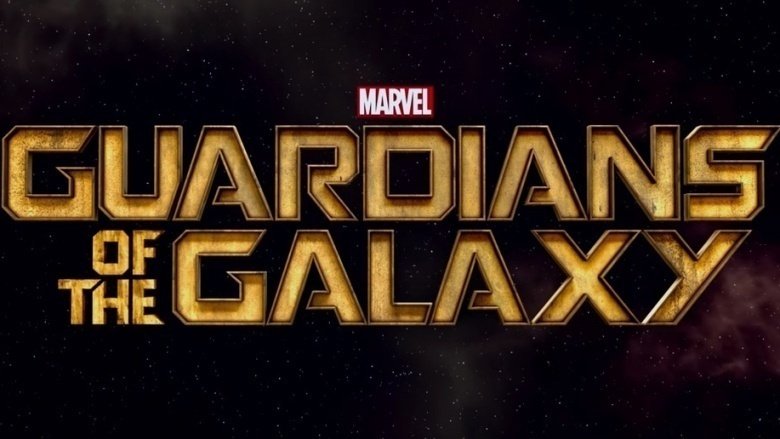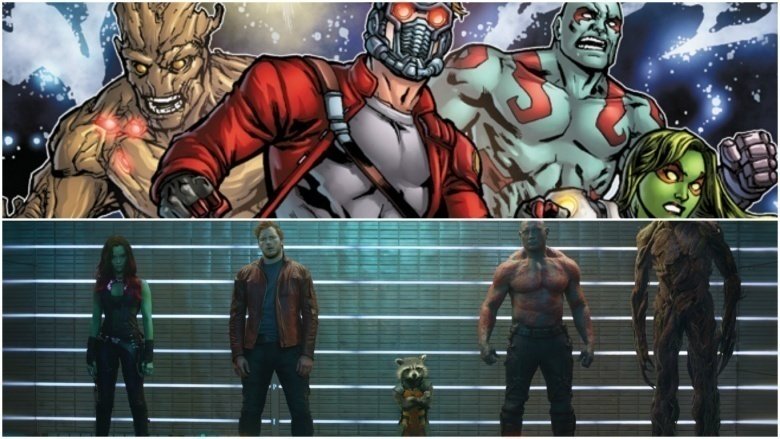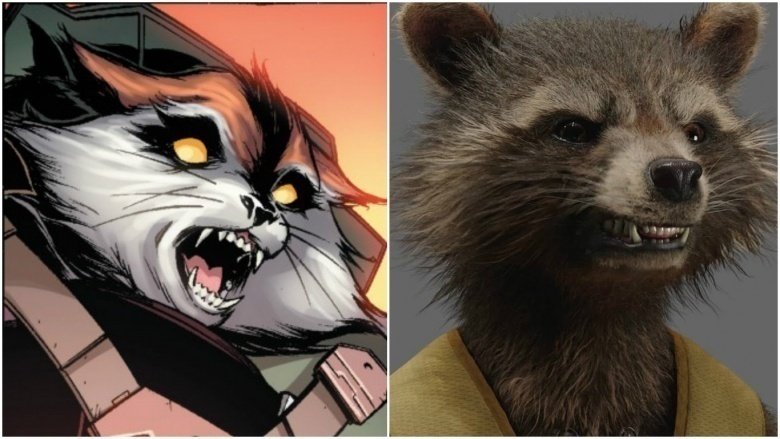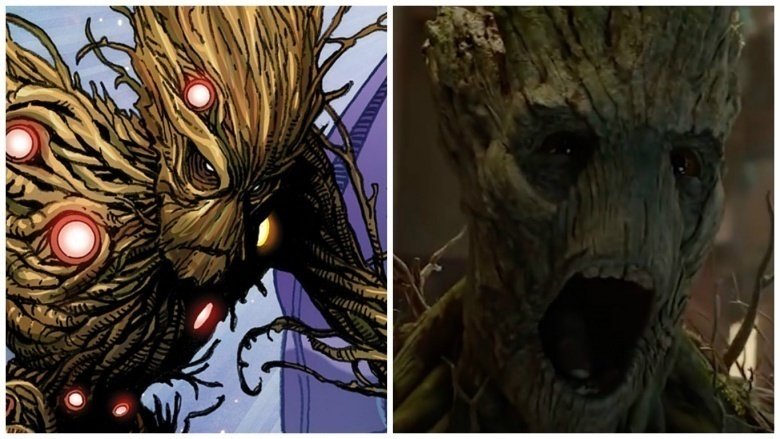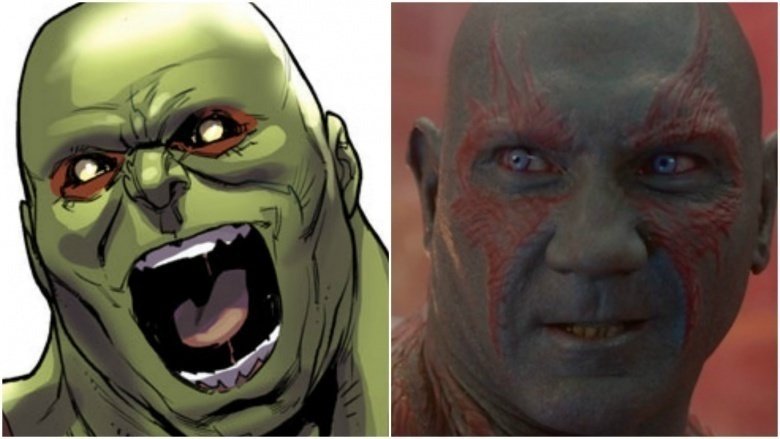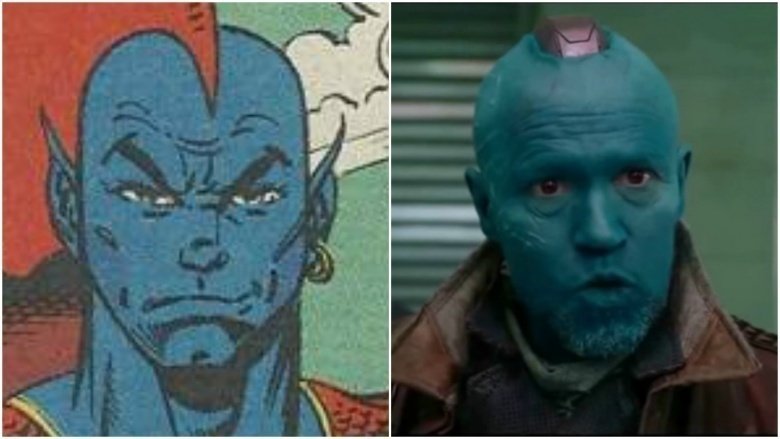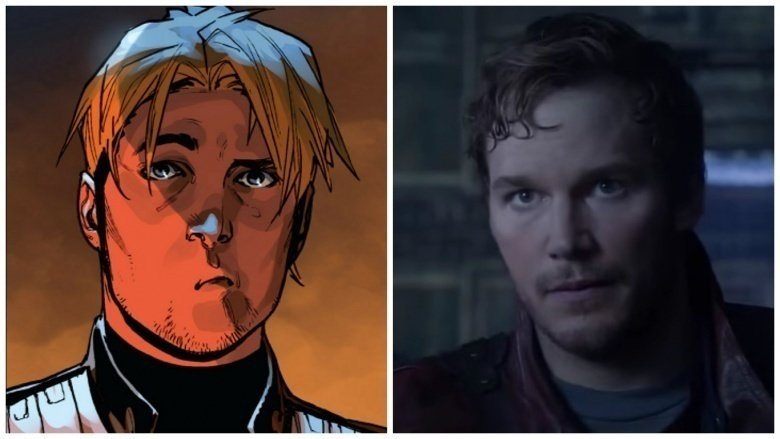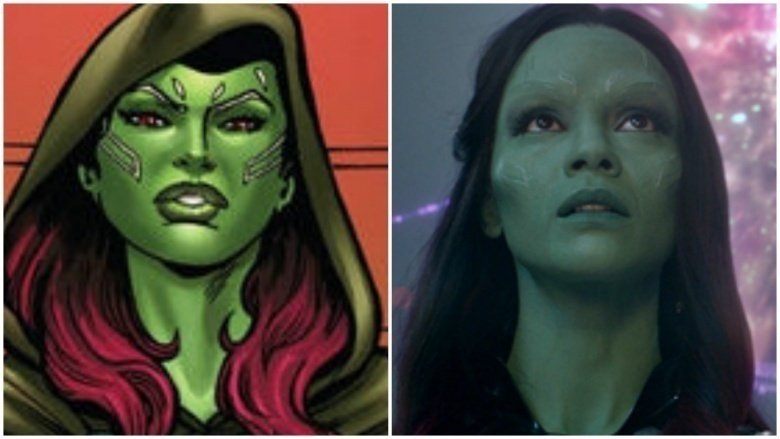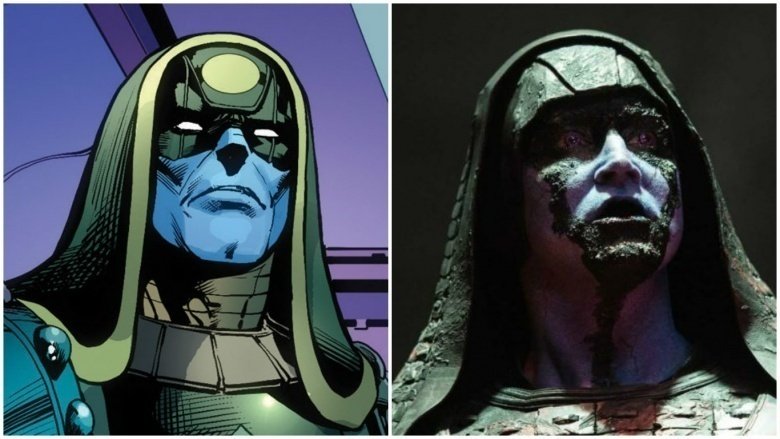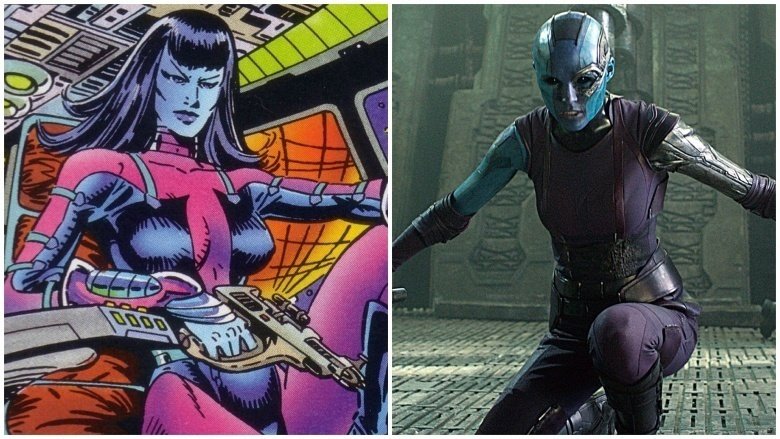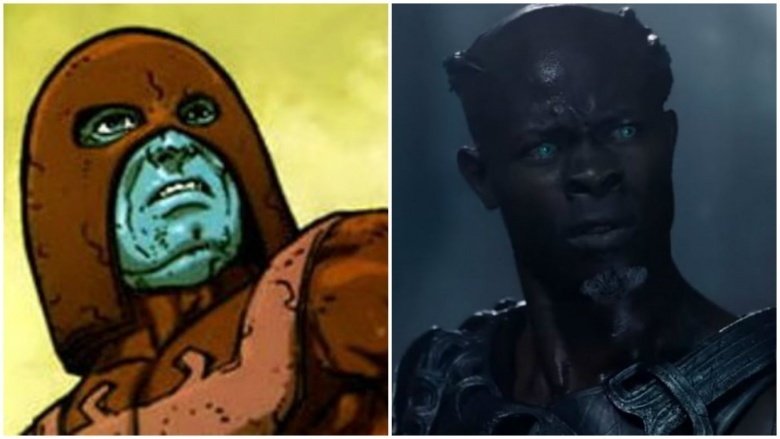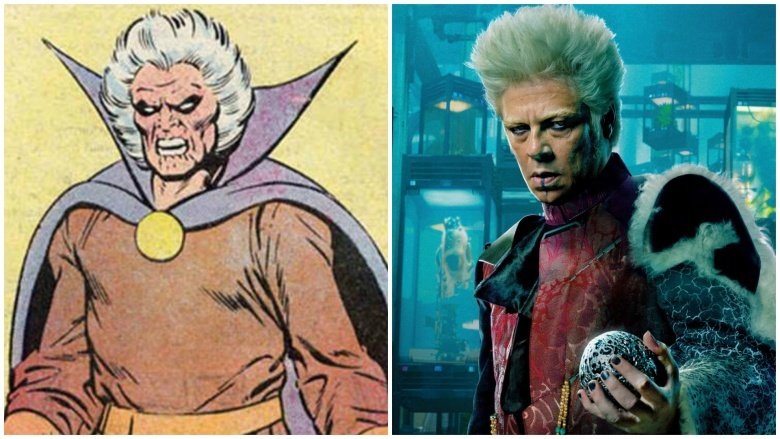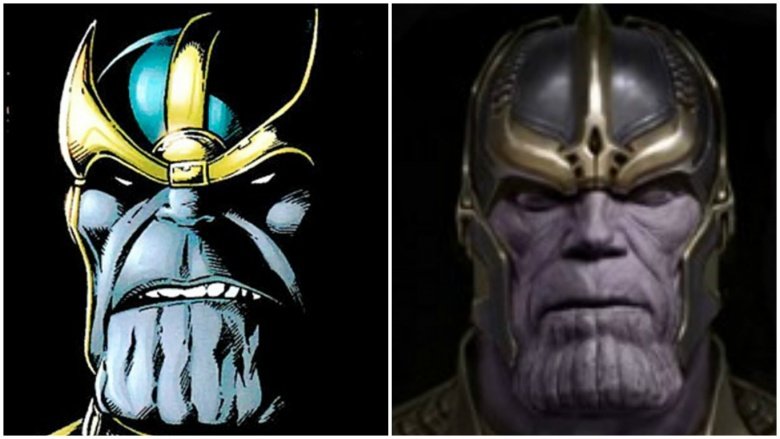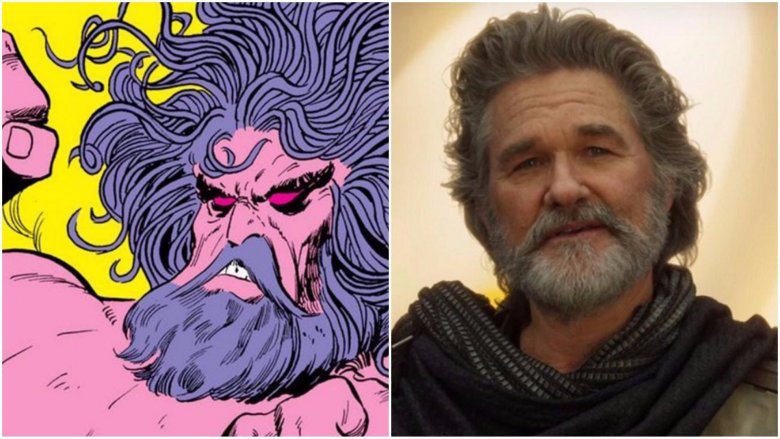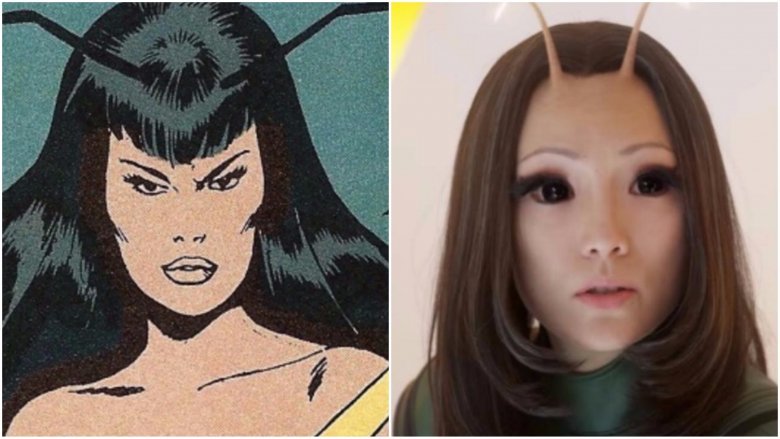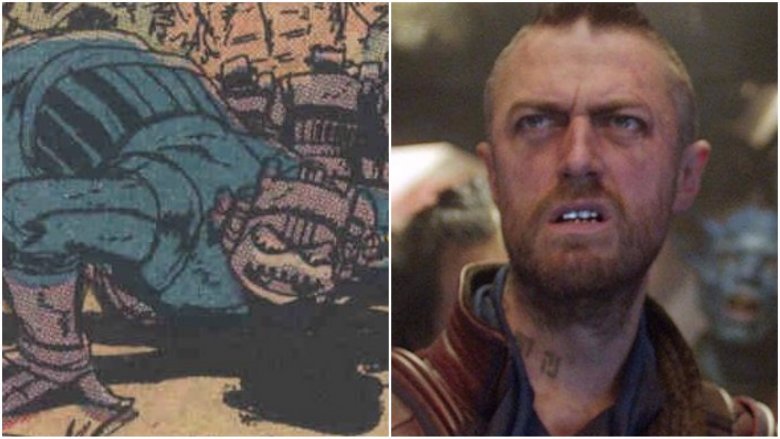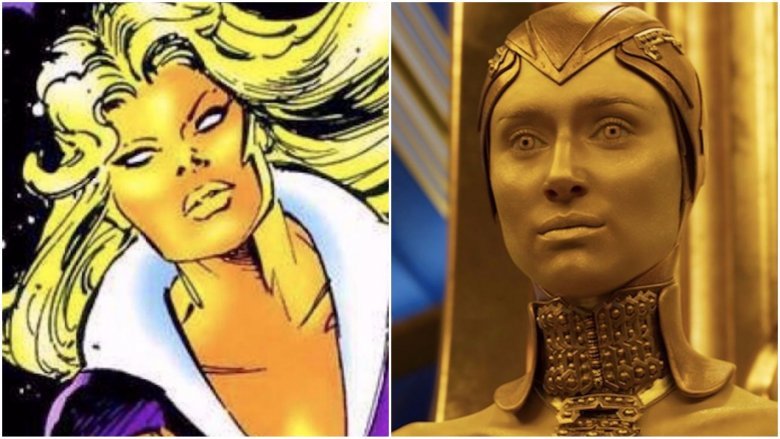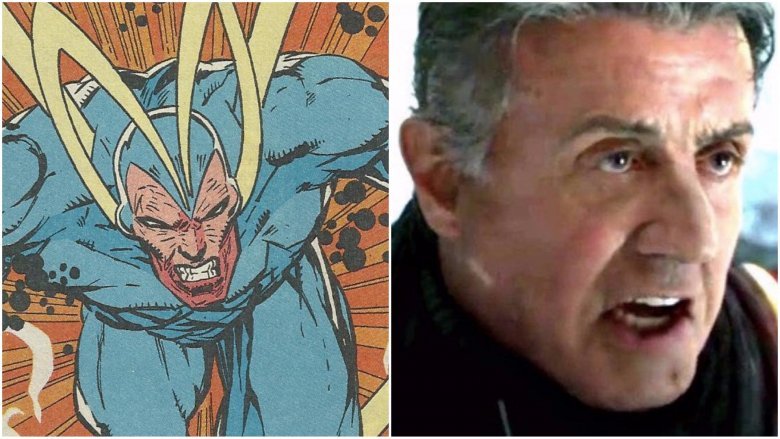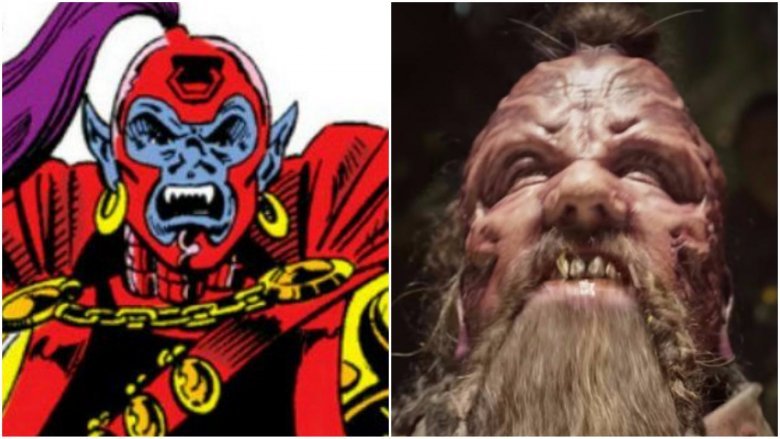How The Guardians Of The Galaxy Characters Are Way Different In The Comics
For years, Marvel's Guardians of the Galaxy comics characters were a relatively obscure property known only to hardcore fans, yet when the team made its big-screen debut in 2014, the movie went on to earn more than $300 million at the box office. This unexpected success was partly owed to the star power of Chris Pratt, Zoe Saldana, the voices of Bradley Cooper and Vin Diesel, a sweet '70s soundtrack, and fun and lively directing and screenwriting from James Gunn, but what many film fans didn't realize is that the characters underwent some major changes on their journey to theaters. Here's a look at how the Guardians of the movies (there's a sequel on the way, of course) compare to the Guardians of the comics.
The team
The movie depicts the meeting and initial team-up of the Guardians of the Galaxy: Star-Lord, Rocket Raccoon, Groot, Gamora, and Drax the Destroyer. But when the team debuted in an issue of Marvel Super Heroes in 1969, almost none of those characters were present. At that point, the Guardians consisted of an astronaut named Vance Astro, Martinex the alien, a human from Jupiter named Charlie-27, and Yondu, a blue-skinned alien archer from somewhere in the vicinity of Alpha Centauri. The only one of those characters who ended up in the movie is Yondu (portrayed by Michael Rooker), and he's not so much a member of the team as he is a bad guy (at least at first).
Rocket Raccoon
In the film, Rocket Raccoon (voiced by Bradley Cooper) is just about the most adorable fuzzy solider of fortune you ever did see, tooling around the universe with his fellow unlikely bounty hunter, a tree-like alien named Groot (Vin Diesel). In the comics, he's from an insane asylum planet (as in the whole planet is an insane asylum) set up by an alien race for care and study of their species' mentally ill. After it loses funding—stay with us here—the planet is abandoned, leaving robots to look after the patients. The robots ultimately achieve sentience and tire of asylum duty, and genetically modify the menagerie of animals left behind by their creators so they can take over. Rocket ends up serving as a sort of sheriff for one of the planet's quadrants—where he's introduced to Marvel readers when the Hulk ends up being accidentally transported there.
Groot
In a movie full of memorable lines, Groot has perhaps the most memorable: "I am Groot." It's actually all he can say. But in his earliest comics appearances, Groot spoke often...and with much foreboding. In Tales to Astonish #13, he visits Earth to warn humanity that it's doomed, declaring himself the ruler of Planet X, and turning a forest into his own army. A scientist devises mutant termites to stop Groot, killing him in their battle, but death didn't stick: in 2006, the character was re-introduced via Guardians, and a few years later was re-imagined as the "I Am Groot" gentle giant of the movies. (Also, for the better part of the movie, it looks like he's about nine feet tall. In the comics, he's often much closer to a 25-footer.)
Drax
Portrayed by the almost inhumanly fit WWE star Dave Bautista, Drax is a violence machine who doesn't understand the nuance of language and is singularly focused on one goal: avenging the death of his family, who were killed by Ronan. In the comics, his origins are a bit more complicated...and kind of silly. Drax began life as a regular human guy (or Terran) named Arthur Douglas who lived in sunny Burbank, California. He and his family were killed by the legendary Marvel baddie Thanos, but before Arthur's soul could completely detach from his body, Thanos' father and grandfather secretly intervened, putting it inside a humanoid figure they'd sculpted out of dirt. Bestowed with superhuman powers and wiped of his human memories, Drax dedicated himself to the single-minded pursuit of Thanos.
Yondu
Yondu has always had a way with arrows. In the comics, he was a noble alien archer who came from the future in an alternate timeline. In the movies, he's still got the arrow, but now he's a rough-around-the-edges intergalactic pirate who uses a magic arrow to steal, pillage, and kill. If you think that makes him sound like a blue, kinda evil Hawkeye, you're not entirely wrong—but Yondu's arrow is different in that it responds to his commands when he whistles, which is pretty cool.
Peter Quill
The movie begins with Peter Quill (although he'd prefer it if you called him Star-Lord) looking around a desolate planet for valuable stuff. He's equal parts thief, pillager, pirate, and salvager, which is a far cry from his original role in the comics: a square-jawed, law-abiding and law-defending space cop (a "guardian of the galaxy," if you will). Though now the main character of Guardians, he didn't appear in the comics until 1976—seven years into the title's existence. But as in the movie, he once did serve time in the prison known as Kyln—although in the comics, he was locked up alongside none other than Thanos.
Gamora
Gamora's backstory is pretty tragic for a comic that leans toward and fun and quirky. After the Badoon exterminated her entire race, she was taken in by Thanos, who trained her to be a killing machine. She eventually turned her back on this messed-up father figure, helping stop his quest to destroy life across the known universe. She was once in a relationship with Nova, resisted a hive-mind takeover, and then joined up the Guardians. Her eventual meet-up with the Guardians is a bit more simplified in the film, and tailored to trigger specific plot points. In the movie, it's said that it was Thanos who killed Gamora's family, although he adopts her and trains her to be a killer anyway, and she's looking to find the Infinity Stone to stop Ronan, who's in cahoots with her adoptive father. Another main point of difference between the comics and movie is Gamora's appearance. In print, she's been most often presented in the typical manner of female comic book characters: very, very little clothing, mostly a few straps to cover up private parts. Director James Gunn rejected that notion, dressing Zoe Saldana in attire more appropriate and practical for a warrior on the move.
Ronan the Accuser
He's a deeply chilling, evil-to-the-core villain bent on victory at any cost in the Guardians of the Galaxy movie (despite being played by Pushing Daisies charmer Lee Pace). Ronan the Accuser doesn't get a whole lot of screen time, and the movie only covers a brief period—not long enough to cover the fact that this is a guy who, in the comics, has switched sides a lot. As Supreme Accuser of the Kree Empire, he's spent a lifetime staging conquests, invading planets, and fighting wars. But that kind of just goes with the territory of being Supreme Accuser: He's a military man for life, and he does what he has to do to get the job done. Heck, even Star-Lord once served as his military adviser. Ronan has even fought alongside the Guardians and their allies from time to time.
Nebula
While Karen Gillan, the actress cast to play Nebula, bears an uncanny resemblance to the Nebula of the comics (even without the blue paint, robot parts, and shaved head), the print and screen versions of the character are quite different. In the movie, Nebula is a loyal servant of Ronan the Accuser. In the comics, she at one point actively fought against Ronan, working with Gamora. (She also once tried to take over Thanos's ship to avenge his murder of her grandfather. Not surprisingly, Thanos nearly killed her, before she was given new life as a cyborg.)
Korath
The Kree-serving Korath of the comics and movie are similarly gruff, intense, and focused on the tasks at hand: war, combat, and destruction. The film doesn't really show him do much of that, however, nor does it reveal much else about the character. In the comics, he's more than just a warrior, he's a brilliant scientist. Korath is a "cyber-geneticist" and gave himself superhuman powers with technology of his own design. His look was also significantly changed for the movie. Gone are the hood-like helmet and blue skin of the comics, in favor of Djimon Honsou in futuristic barrettes and spooky contact lenses.
The Collector
Benicio del Toro makes brief appearances in Thor: The Dark World and Guardians of the Galaxy as the mysterious Taneleer Tivan, also known as the Collector. Gamora is trying get an Orb with an Infinity Stone in it to the Collector, because he's a being that collects artifacts from civilizations across the universe. That short, plot-instigating moment belies the fact that the Collector is one of the oldest and most enduring characters in Marvel Comics, interacting with everyone from the Silver Surfer to the X-Men over the past 40 years. As an Elder of the Universe, he's more than five billion years old, and he owes his vitality to his love of collecting interesting objects and living things so as to save them from oblivion. That all stems from his gift of prophecy: He once had a vision of a major threat to all life—which would turn out to be Thanos. Acting on that need to preserve, the Collector once even tried to "collect" the Avengers.
Thanos
In the movie, Gamora's desire to stop her adoptive father (who's still a bloodthirsty force of pure evil bent on death and destruction) is a major reason why the Guardians are looking for the Infinity Stone. That carries over from the comics, but Thanos also had an ability to separate his work life from his home life. To wit: He took his role as Gamora's de facto dad seriously, and even gave her nice Christmases when she was a little kid with the tree, presents, and the whole works. As for those Infinity Stones he's after in the movie, they're much more important in the comics, and for a much longer time. Called the Infinity Gems, Thanos has gotten his hands on them on a number of occasions—and lost them again every time.
Ego
A lot of pre-release buzz over Guardians of the Galaxy Vol. 2 concerned the casting of Kurt Russell as the long-lost father of Peter "Star-Lord" Quill, but the movie diverged from the comics in a big way. In print, Star-Lord's dad is an alien named J'son, making the younger man half-human, half-alien. On screen, his papa is a different Guardians of the Galaxy comics character: Ego the Living Planet. Ego's movie version takes human form, as played by Russell, and explains he's a Celestial—a godlike being in the Marvel Universe, making Peter a pretty powerful hybrid. While the look of Russell as man-form Ego gets the beard and up-do right, he lacks the purple hair (and pink skin) sported by his comics counterpart's humanoid guise.
Mantis
Ego's not the best dude, what with his obsessive need to remake the universe the way he wants it. Helping him do his bidding is the bug-like, shy, empathic Mantis (Pom Klementieff). The Guardians effects crew took some liberties with the look of the character to make her more film-ready while also emphasizing her buggy characteristics. As Mantis originally appeared in print, she had a very human looking face with her insect-like antennae sprouting out from under bangs. In Vol. 2, Mantis is bug-eyed (quite literally—they're huge), and the antennae jut out from the forehead, front and center.
Kraglin
While Kraglin (Sean Gunn) was a part of the first Guardians of the Galaxy, film, loyally serving Yondu (Michael Rooker) and appearing beside him almost every time he was onscreen, the character gets more of a chance to shine in Guardians of the Galaxy Vol. 2. (He also eventually gets a pretty sweet weapons upgrade in the form of Yondu's mind-powered deadly arrow thing.) It's a better look than the one he had in the comics, where he was some kind of robot-meets-Gollum creature.
Ayesha
If only Peter Quill's mother had had the foresight to put Fleetwood Mac's "Gold Dust Woman" on one of those mixtapes, he and the other Guardians might have been more prepared for the powerful Ayesha (Elizabeth Debicki), the golden leader of the Sovereign. Historically, technological and financial constraints have made movies far more visually limited than the comics, where the only ceiling is what artists can draw. And yet the comics' Ayesha just isn't as eye-popping as the movie version—she's got more of a tanned, blond California vibe than a look that screams "all-powerful alien ruler."
Starhawk
Was Sylvester Stallone cast in Guardians of the Galaxy Vol. 2 simply to create a de facto Tango and Cash reunion with co-star Kurt Russell? Perhaps. But he also really looks like a past comic book incarnation of his character, Stakar Osgord, supreme leader of the Ravagers. In the comics, this character is also known by his superhero name: Starhawk. Going on appearances alone, director James Gunn got the perfect guy for the part—Stallone's naturally got the same pointy nose and scowling mouth as his comics inspiration. No blue mask, though. Maybe in Vol. 3.
Taserface
Filmmakers certainly nailed the feel of the frightening Taserface (Chris Sullivan). And a lot of the details from the comic (he's relatively obscure, and appeared in just a few issues in the '90s) manifest on the screen. Angry eyes? Check. Craggy, knife-like teeth? Check? Cool, ancient warrior-style ponytail? Check. Movie Taserface is so imposing, making his hair purple might have undermined the effect. The same thing goes for the mask—why put a guy who so known for his face under something that'll hide it? They could have given him blue skin for the movie, but that's probably strictly Yondu's domain at this point.
